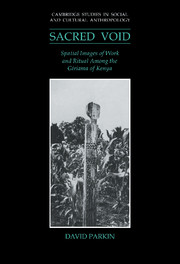Book contents
- Frontmatter
- Contents
- List of illustrations
- Preface
- Introduction
- 1 Fantasies of the west
- 2 Western Kaya, sacred centre
- 3 View from the west: cattle and co-operation
- 4 From west to east: the works of marriage
- 5 Spanning west and east: dances of death
- 6 Alternative authorities: incest and fertility
- 7 Alternative selves: invasions and cures
- 8 Coastal desires and the person as centre
- Conclusion
- Appendix 1 Three ecological zones and demographic features of southern Kilifi District
- Appendix 2 Giriama kinship and affinal terms
- Appendix 3 Giriama cattle terms
- Appendix 4 Giriama patri-clan structure
- Bibliography
- Index
- Cambridge Studies in Social and Cultural Anthropology
Appendix 4 - Giriama patri-clan structure
Published online by Cambridge University Press: 03 November 2009
- Frontmatter
- Contents
- List of illustrations
- Preface
- Introduction
- 1 Fantasies of the west
- 2 Western Kaya, sacred centre
- 3 View from the west: cattle and co-operation
- 4 From west to east: the works of marriage
- 5 Spanning west and east: dances of death
- 6 Alternative authorities: incest and fertility
- 7 Alternative selves: invasions and cures
- 8 Coastal desires and the person as centre
- Conclusion
- Appendix 1 Three ecological zones and demographic features of southern Kilifi District
- Appendix 2 Giriama kinship and affinal terms
- Appendix 3 Giriama cattle terms
- Appendix 4 Giriama patri-clan structure
- Bibliography
- Index
- Cambridge Studies in Social and Cultural Anthropology
Summary
Spear (1978: 52–53) provides a compilation of the six Giriama ‘clans’ (or what I prefer to call sections since they are not exogamous, though may once have been), and their constituent ‘sub-clans’ (or what I prefer to call clans, since they are usually the minimal units of exogamy nowadays). Spear's compilation is based on that of earlier writers, including Werner (1915: 326–354) and Champion (1967: 54–55). It differs only slightly from that of Brantley-Smith (1973:53). In 1966, I found Champion's compilation to be remarkably similar to the list of clans (i.e. Spear's sub-clans) independently cited by people in the area of Kaloleni where I carried out my first fieldwork, although younger people were, not surprisingly, less consistent than elders, especially as regards the relationship to each other both of the six sections and of the constituent clans. In Kayafungo location in 1985, during fieldwork there, I used Spear's list as a basis for reconstructing settlement patterns and movements, and here add comments alongside Spear's compilation. I also have extensive data on inter-clan marriage which, together with local people's own classification, indicate how much more variable are interrelations between clans than our lists have been able to indicate. In collecting such data, I merely asked people what their and their spouses' clans were.
- Type
- Chapter
- Information
- The Sacred VoidSpatial Images of Work and Ritual among the Giriama of Kenya, pp. 242 - 246Publisher: Cambridge University PressPrint publication year: 1991



